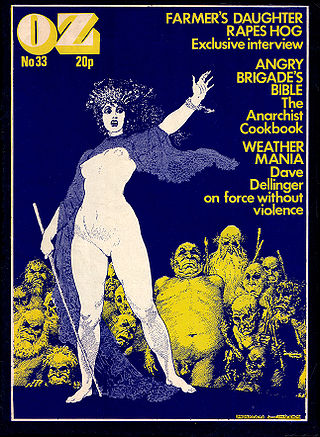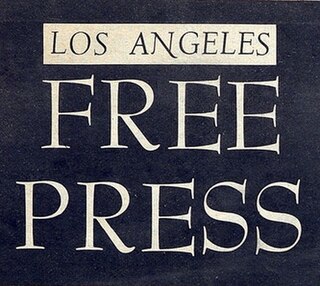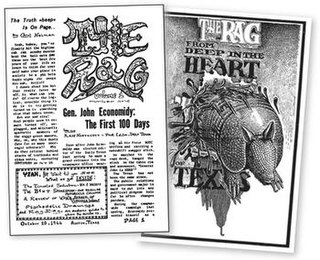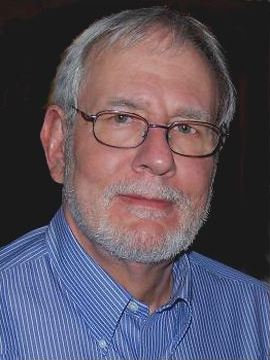
Fifth Estate is a U.S. periodical, based in Detroit, Michigan, begun in 1965.
Dispatch or dispatches may refer to:

The Riverfront Times (RFT) is a free progressive weekly newspaper in St. Louis, in the U.S. state of Missouri, that consists of local politics, music, arts, and dining news in the print edition, and daily updates to blogs and photo galleries on its website. As of June 2008, the Riverfront Times has an ABC-audited weekly circulation of 81,276 copies.

The terms underground press or clandestine press refer to periodicals and publications that are produced without official approval, illegally or against the wishes of a dominant group. In specific recent Asian, American and Western European context, the term "underground press" has most frequently been employed to refer to the independently published and distributed underground papers associated with the counterculture of the late 1960s and early 1970s in India and Bangladesh in Asia, in the United States and Canada in North America, and the United Kingdom and other western nations. It can also refer to the newspapers produced independently in repressive regimes. In German occupied Europe, for example, a thriving underground press operated, usually in association with the Resistance. Other notable examples include the samizdat and bibuła, which operated in the Soviet Union and Poland respectively, during the Cold War.
Liberation News Service (LNS) was a New Left, anti-war underground press news agency that distributed news bulletins and photographs to hundreds of subscribing underground, alternative and radical newspapers from 1967 to 1981. Considered the "Associated Press" for the underground press, at its zenith the LNS served more than 500 papers. Founded in Washington, D.C., it operated out of New York City for most of its existence.
The Underground Press Syndicate (UPS), later known as the Alternative Press Syndicate (APS), was a network of countercultural newspapers and magazines that operated from 1966 into the late 1970s. As it evolved, the Underground Press Syndicate created an Underground Press Service, and later its own magazine.
The United States Student Press Association (USSPA) was a national organization of campus newspapers and editors active in the 1960s. A program of the National Student Association (NSA), the USSPA formed a national news agency for college publications called Collegiate Press Service.
Collegiate Press Service, also called College Press Service (CPS), was a news agency supplying stories to student newspapers. It operated under various owners and names from 1962 to c. 1999.
Raymond A. Mungo is an American author, co-author, or editor of more than a dozen books. He writes about business, economics, and financial matters as well as cultural issues.
An alternative news agency operates similarly to a commercial news agency, but defines itself as an alternative to commercial or "mainstream" operations. They span the political spectrum, but most frequently are progressive or radical left. Sometimes they combine the services of a news agency and a news syndicate. Among the primary clients are alternative weekly newspapers.

The Los Angeles Free Press, also called the "Freep", is often cited as the first, and certainly was the largest, of the underground newspapers of the 1960s. The Freep was founded in 1964 by Art Kunkin, who served as its publisher until 1971 and continued on as its editor-in-chief through June 1973. The paper closed in 1978. It was unsuccessfully revived a number of times afterward.

The Great Speckled Bird was a counterculture underground newspaper based in Atlanta from 1968 to 1976 and 1988 through 1990. Commonly known as The Bird, it was founded by New Left activists from Emory University and members of the Southern Student Organizing Committee, an offshoot of Students for a Democratic Society. Founding editors included Tom and Stephanie Coffin, Howard Romaine and Gene Guerrero Jr. The first issue appeared March 8, 1968, and within 6 months it was publishing weekly. By 1970 it was the third largest weekly newspaper in Georgia with a paid circulation of 22,000 copies. The paper subscribed to Liberation News Service, a leftist news collective. The office of The Great Speckled Bird at the north end of Piedmont Park was firebombed and destroyed on May 6, 1972. In a letter to the editor of the New York Review of Books, Jack Newfield et al. noted that the bombing occurred after the paper published an exposé of the mayor of Atlanta.
Dispatch News Service International (DNSI) was an alternative news agency that operated from 1968 to 1973. Initially focusing on in-depth reporting on the Vietnam War, DNS as it was commonly known, established its main operations in Saigon, South Vietnam. Reporters traveled extensively throughout Southeast Asia, reporting from various capitals, but its focus remained the countries of Cambodia, Laos, and Thailand.

Jonah Raskin is an American writer who left an East Coast university teaching position to participate in the 1970s radical counterculture as a freelance journalist, then returned to the academy in California in the 1980s to write probing studies of Abbie Hoffman and Allen Ginsberg and reviews of northern California writers whom he styled as "natives, newcomers, exiles and fugitives." Beginning as a lecturer in English at Sonoma State University in 1981, he moved to chair of the Communications Studies Department from 1988 to 2007, while serving as a book reviewer for the San Francisco Chronicle and the Santa Rosa Press-Democrat. He retired from his teaching position in 2011.

The Rag was an underground newspaper published in Austin, Texas from 1966–1977. The weekly paper covered political and cultural topics that the conventional press ignored, such as the growing antiwar movement, the sexual revolution, gay liberation, and drug culture. It encouraged these political constituencies and countercultural communities to coalesce into a significant political force in Austin. As the sixth member of the Underground Press Syndicate and the first underground paper in the South, The Rag helped shape a flourishing national underground press.
The Columbus Free Press is an American alternative journal published in Columbus, Ohio, since 1970. Founded as an underground newspaper centered on anti-war and student activist issues, after the winding down of the Vietnam War it successfully made the transition to the alternative weekly format focusing on lifestyles, alternative culture, and investigative journalism, while continuing to espouse progressive politics. Although published monthly, it has also had quarterly, bi-weekly and weekly schedules at various times in its history, with plans calling for a return to a weekly format by the end of 2014.

San Francisco Express Times was a counterculture tabloid underground newspaper edited by Marvin Garson and published weekly in San Francisco, California from January 24, 1968, to March 25, 1969, for a total of 62 issues, covering and promoting radical politics, rock music, arts and progressive culture in the Bay Area. It was a member of the Underground Press Syndicate, and sold for 15 cents.

Space City! was an underground newspaper published in Houston, Texas from June 5, 1969 to August 3, 1972. The founders were Students for a Democratic Society veterans and former members of the staff of the Austin, Texas, underground newspaper, The Rag, one of the earliest and most influential of the Sixties underground papers. The original editorial collective was composed of Thorne Dreyer, who had been the founding "funnel" of The Rag in 1966; Victoria Smith, a former reporter for the St. Paul Dispatch; community organizers Cam Duncan and Sue Mithun Duncan; and radical journalists Dennis Fitzgerald and Judy Gitlin Fitzgerald.

Thorne Webb Dreyer is an American writer, editor, publisher, and political activist who played a major role in the 1960s-1970s counterculture, New Left, and underground press movements. Dreyer now lives in Austin, Texas, where he edits the progressive internet news magazine, The Rag Blog, hosts Rag Radio on KOOP 91.7-FM, and is a director of the New Journalism Project.
Columbus, Ohio is served by several newspapers, magazines, and television and radio stations.










